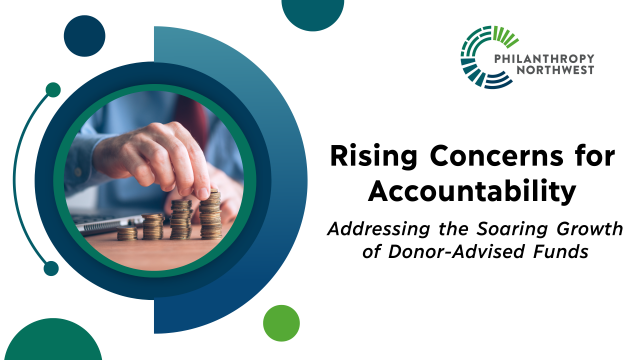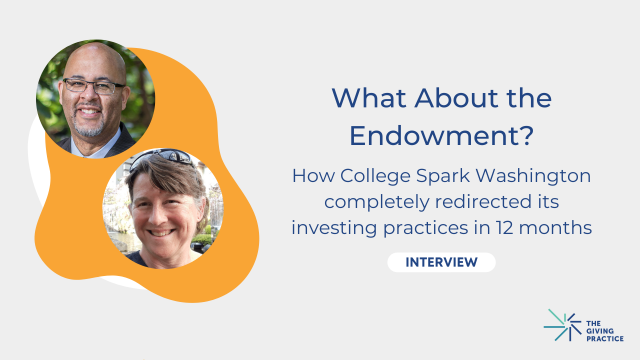by Nazim Karmali and Robert Harding, Pacific Continental Bank
It’s a basic tenet of economic theory that scarcity creates worth. That is why precious metals are worth more than rocks. Gold is rare, difficult and expensive to find, whereas rocks are not. And while that’s great for the worldwide gold market, it’s not so great if the principle of scarcity refers to such vital needs like water, food or money.
In the world of foundations and the nonprofits they fund, access to capital is often a scarce resource, but more narrowly defining the issue, collateral to secure loans for such things as capital campaigns or equipment purchases, may be the precious metals that nonprofits need and foundations can help provide.
Recently, banks who work with foundations and nonprofits began moving toward a different loan program called the “credit holder model,” which can open up a whole new world of collateral access. This credit holder model is in many ways a program to facilitate mission investing and is something our bank and others are turning to more and more to help nonprofits get the loans they need and foundations the investments they want.
Here is an example of how it works. A small nonprofit needs funding to complete renovations of leased space to grow their service delivery program. Their business plan is to obtain a loan and then take the revenues from the expanded program and turn it around to repay the debt. But, there was no collateral available from the nonprofit to secure the much needed loan. And since their repayment is dependent on program success, the nonprofit may get stuck: no collateral, no loan and no new program to generate revenue for new services.
However, the nonprofit’s bankers could work with them to secure a loan using the credit holder model. The bank and the nonprofit would work to find a group of supporters (foundation grants and individuals) to open Certificates of Deposits (CDs) and pledge them as collateral for the debt. This can quite simply kick open the door for the nonprofit to get the space they need to expand services.
The line of credit is needed as a bridge that will create funding for a “now” need but is assured of future repayment. Here is when the development team crafts and implements a strategy to seek funding from public sources, foundations, corporations and individuals to fund the endeavor. The donated income is used to pay off the line of credit, the job is accomplished and the credit holders receive the funds back.
Is there risk involved? Yes, the bank considers the line of credit an asset and will rely on the nonprofit to work within the terms and conditions of the line. The line will never convert to a donation; it is meant to provide working capital for a specific time and purpose.
Fast forward in time, the loan performed as planned and each supporter was released from their collateral obligation. Further, it allowed for multiple “bites at the apple” in terms of funders helping the nonprofit. Funders can pledge collateral or offer guarantees on debt obligations of nonprofits, AND have capacity to duplicate efforts each time a loan is repaid since their funds would be released from obligation and available to use again.
Here’s another example of how it could work. Let’s say a large foundation is intent on providing a mission-compatible nonprofit $1 million to help construct a new building, which will allow for expanded services. The foundation could pledge the money as collateral for the nonprofit to secure a loan from a bank. When the loan is repaid, the foundation will get their money back, and if they want, can pledge the money as collateral again. The bank pays interest on the cash (albeit a nominal amount) and in the end, you have a great partnership between the financial institution, funder and nonprofit.
Additionally, the credit holder model is an example of other creative solutions in finding hard to access capital. Having a solid and consultative relationship with your banker is one of the best ways to further research and learn about the best ways to generate and use revenue.
Indeed, money is and always will be a scarce and precious resource. As such, the job of foundation professionals, nonprofit professionals and banking professionals should be to find creative ways to mine that resource for the betterment of all. Luckily, solutions like the credit holder model just might be the gold being sought by all.
Nazim Karmali is the market president for Pacific Continental Bank in the Greater Seattle market. Robert Harding is the market president for Pacific Continental Bank in Greater Portland. They can be reached at: nazim.karmali@therightbank.com and robert.harding@therightbank.com.



Comments
Fascinating idea! I have
Fascinating idea! I have reposted this article on the Grants Managers Network member community.